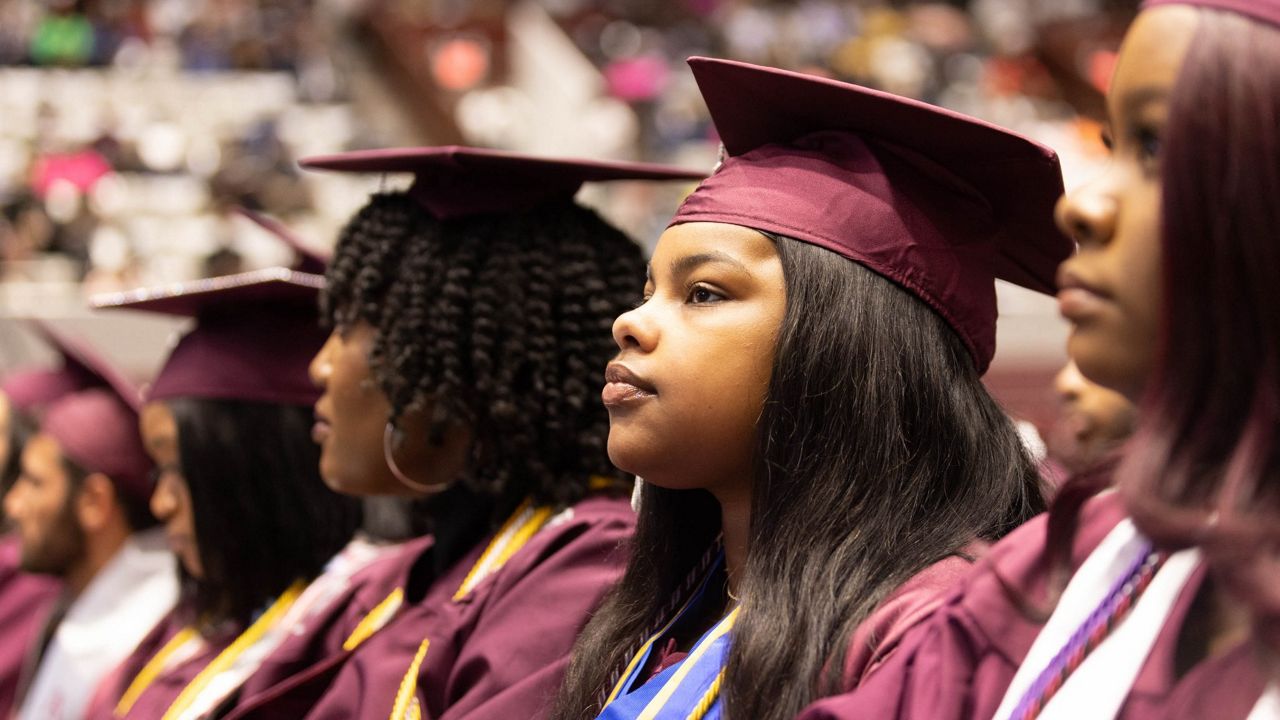CARY, N.C. — What if you could talk to your children before they start speaking?
The Learning Experience has made American Sign Language a key component of educational material for children in the earlier stages of life.
- The Learning Experience child care center in Cary embraces American Sign Language as a way to communicate with children not enough to speak
- Teachers incorporate ASL into daily classroom activities
- Toddlers are learning to sign before they talk
- Shannon Bushway, 28, has taught at the TLE since 2018
- Cost of attendance may not be affordable for all
The child care development franchise has locations around the nation.
The director of the Cary day care center said infants and toddlers using their hands is a natural form of early communication.
“Especially with the younger children, the biggest thing is their communication. The communication is the key to their learning. If they can communicate with the children, it can make it much easier for the teacher to know what they want and the child to know what they need,” Dia Shah said.
Shah has run the facility for 14 years.
“To be able to talk to and interact with adults and, of course, there are infantiles who do not have their words yet. We can teach them a sign language to give them a baseline for language,” Shah said.
Excitement is a part of every school day. Working with toddlers can be like teaching a moving target, according to one instructor.
“For the most part, I always try to use my words with the sign so they can use the audio with the hand gestures,” Shannon Bushway said.
Bushway motioned to a classroom of rambunctious students whose own name they can’t say. Every child cross-legged on the floor or standing with a block in their hand mostly grunts if they try to speak. She is continually practicing different signs with the little ones. The teacher touched her chin with her fingers extended to show “thank you.”
The 28-year-old pointed to an open container full of oversized Legos. “Put it in the bucket. Help clean up. Thank you,” she gestured as they followed her lead.
Information is like glue if you can get their attention. Most of the children are between 14-20 months old and can’t talk using words, but these little ones hold on to everything… literally.
Bushway said signing with them sticks in their brains more than you think.
“It’s great to help them communicate when they are so little,” the teacher said.
It’s why non-verbal communication is part of the curriculum.
Bushway has worked in early childhood education since 2018. The teacher said their approach to education contours to the needs of their mobile student population.
“Look at the sign for cow,” Bushway said as she read a book to the class.
Story time is a daily class assignment and so is singing.
“The babies on the bus go wah wah wah, wah wah wah,” the instructor sang to her students. “Wheels on the Bus” still seems to be a useful children’s melody in 2022.
Ironically, a baby’s actions can speak louder than words. When Bushway raised her finger to quiet the class, so did two of her students. Some expressions don’t need to be spoken,
“[Sign language] is such a great way that they can communicate and learn when we know they are taking in the information they just might not be able to communicate it verbally yet. Being able to sign is so important,” Bushway said.
Bushway understands what it is like to reach younger people. The educator has a 5-year-old son and entered the field of child care in Massachusetts at another TLE center four years ago.
The mother came home every day after work to practice signing with her baby boy.
When they moved to North Carolina, she became fluent. “Continued my sign language education with my kids. As they were learning, I was learning as well,” Bushway said.
Children are in a constant state of engagement with themselves, classmates, inanimate objects and adults, so the program is built on turning the world they live in into a classroom.
The small student to teacher ratio allows for one-on-one instruction. Bushways said at this age, they are still learning how to regulate and process their emotions.
“I feel like sometimes they have all these choices they have to make and they definitely know what they want, but sometimes they just need a little bit of assistance getting to their end goal without a lot of big feelings,” Bushway said.
By discovering the space around them, they can discover themselves. Bushway said developing strong cognitive, social and motor skills only happens if the child feels comfortable in their environment.
“I just try to work with them one-on-one and help them regulate their emotions to achieve whatever it is they are trying to do,” Bushway said.
Whether it be picking a color to draw on paper or finding the right sippy cup to drink their milk.
This innovative style of education isn’t cheap, however. The director said the family of preschoolers can pay $1000 a month.
The parents of infants can pay up to $1,300 a month.
Shah said grants are available for children who cannot afford the tuition.
Because you can’t teach who you can’t reach.
This program is built on turning the world in which they live into a classroom.
Children are in a constant state of engagement with themselves, classmates, inanimate objects and adults.
The small student to teacher ratio allows for one-on-one instruction. Bushways said at this age they are still learning how to regulate and process their emotions.
"I feel like sometimes they have all these choices they have to make and they definitely know what they want but sometimes they just need a little bit of assistance getting to their end goal without a lot of big feelings,” Bushway said.
By discovering the space around them they can discover themselves. Bushway said developing strong cognitive, social and motor skills only happens if the child feels comfortable in their environment.
“I just try to work with them one-on-one and help them regulate their emotions to achieve whatever it is they are trying to do,” Bushway said.
Whether it be picking a color to draw on paper or finding the right sippy cup to drink your milk.
This innovative style of education isn’t cheap. The director said the family of preschoolers can pay $1000 a month.
The parents of infants can pay up to $1,300 a month.
Shah said grants are available for children who cannot afford the tuition.










